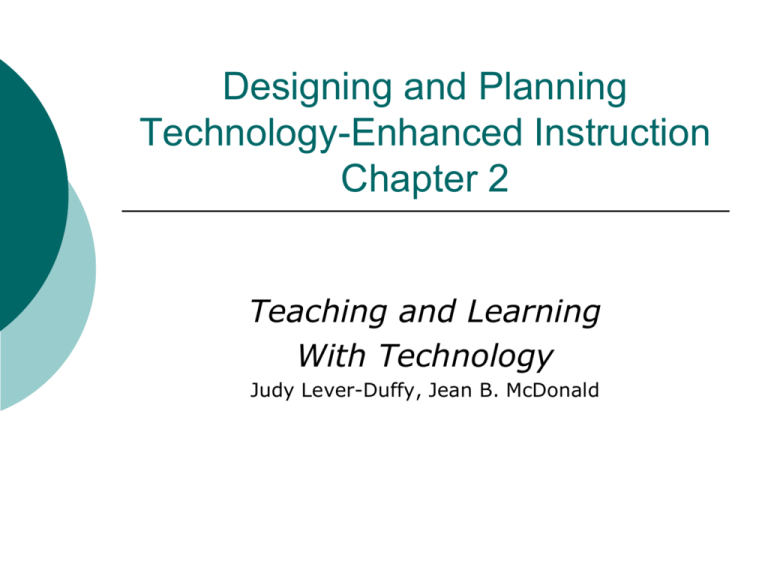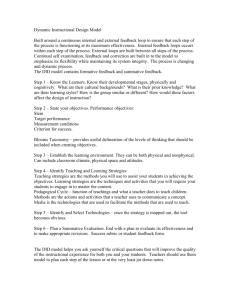Designing and Planning Technology
advertisement

Designing and Planning Technology-Enhanced Instruction Chapter 2 Teaching and Learning With Technology Judy Lever-Duffy, Jean B. McDonald Effective Learning Environment “A learning environment includes all conditions, circumstances, and influences that affect the learner’s development.” Physical environment Teaching and learning process Strategies and technologies Interaction Assessment techniques Requires systematic planning Instructional Planning System Design-Plan-Act (DPA) Design: Design the instructional unit (Create your unit design) Plan: Articulate specific lesson plans (Design your daily lessons) Act: Develop an instructional action plan (Write the to-do lists) Dynamic Instructional Design (DID) Continually growth and adjustment based on data provided by ongoing feedback p. 49 Step 1: Know the Learners Developmental stages Cultural or language backgrounds Incoming skills and knowledge Learning & cognitive styles, types of intelligence Group similarities and differences and how they might affect the design Step 2: State Your Objectives Use Performance Objectives Use action verbs Use Depth of Knowledge to target higher order thinking skills (not Bloom’s Taxonomy) http://dese.mo.gov/divimprove/sia/msip/ DOK_presentation.pdf Performance Objectives Example: The student will be able to identify latitude and longitude lines on a map with 100 % accuracy. Stem: The student will be able to Target performance: …identify latitude and longitude lines… Measurement conditions: …on a map… Criterion for success: with 100% accuracy. Depth of Knowledge (DOK) There are four levels of DOK 1. Recall 2. Skill/Concept 3. Strategic Thinking 4. Extended Thinking http://www.missouriartscouncil.org/html/documents/DOKlevels.pdf http://www.hermann.k12.mo.us/Curriculum/DOK /depth.of.knowledge.descriptors.pdf This diagram shows the four DOK levels, associated verbs and sample activities. A full sized chart can be found in the Chapter Two folder on Blackboard. Step 3: Establish the Learning Environment Physical space Classroom climate Well-lit reading areas Warmer or cooler sections Informal seating areas Quiet or screened study areas Flexibility, cooperation, healthy competition, active learning Attitudes Teacher positive and encouraging Students confident Step 4: Identify T & L Strategies Teaching strategies Learning strategies Methods used to assist students in achieving the objectives Techniques and activities students are required to engage in to master the content Teaching and learning strategies are components of the Pedagogical Cycle Pedagogical Cycle p. 60 Step 5: Identify & Select Technologies “Instructional technologies are the tools used to enhance and support the teaching and learning strategies planned…” “…technology’s primary role is in support of the strategies …select[ed]” Step 6: Plan Summative Evaluation Evaluate effectiveness Make appropriate revisions Ultimate evaluation is students’ performance based on instructional objectives Use student achievement and other feedback to make improvements in your instructional design p. 64-65 3e Lesson Planning Lesson plan is the daily instructional guideline Follows same basic organization as the instructional design Lesson plan steps are 1. 2. 3. Readying the learners Targeting specific objectives Preparing the lesson p.70-71 Lesson Plan (cont.) STEP 3: PREPARE THE LESSON (cont.) EXAMPLES (cont.) Technology/Media Preparation Scan, print, and make copies of bank center forms. Enlarge one of each and laminate them. Prepare money equivalence transparencies. Create a chart of bank processes on a computer, print out, enlarge, and laminate. Locate a suitable bank web site to share. Assessment Preparation Prepare and administer a quiz asking students to fill in each type of form and to compute their account balances. Instructional Action Planning Articulate your lesson’s to-do list Detail all preparations necessary for a successful lesson The action planning steps are: 1. 2. 3. 4. 5. 6. 7. Identifying learner preparation activities Getting classroom ready Listing teaching-learning activities Creating personal prompts Listing support technologies Listing feedback instruments Detailing follow-up activities p. 72-73 Action Planner (cont.) TO-DO #5: LIST SUPPORT TECHNOLOGIES Describe the things you need to do to ensure that the technologies you have selected are available and working. • What technologies and related materials need to be acquired for another source? From where? • What hardware or software adjustments need to be made? • Which technologies need to be checked to be sure they are functioning? EXAMPLE Technology Checklist ___ Make sure the scanner is working. ___ Check the printer cartridge. ___ Get colored paper from the art room. ___ Get ink-jet transparency film from the office. ___ Install a software upgrade. ___ Print the home page of web sites on which to make notes. ___ Check the LCD display for all cables and to be sure it is working TO-DO #6: LIST FEEDBACK INSTRUMENTS Describe the feedback instruments you need to have ready for this lesson. • What do you need for formative feedback? • What do you need for summative feedback? EXAMPLE Feedback Checklist ___ Rubric for assessing performance while at the bank center ___ Quiz on filling in forms and determining balances ___ Lesson objective test on terms and concepts ___ Student satisfaction questionnaire TO-DO #7: DETAIL FOLLOW-UP ACTIVITIES Given the feedback, describe the follow-up activities. • If the lesson was not successful, what remediation is planned? • If the lesson was successful, what reinforcement is planned? EXAMPLE Remediation: PowerPoint self-paced review of key terms followed by a quiz on key points; direct tutoring or peer mentoring if mastery is not demonstrated on quiz Reinforcement: Continued use of the bank center for a token-economy reward system Planning, Teaching, Learning and Technology Design Plan Narrows the planning to a specific objective and knowledge segment Act Blueprint of overall unit Lesson plan to-do list Technology Only after instructional planning complete Make better or create new possibility






